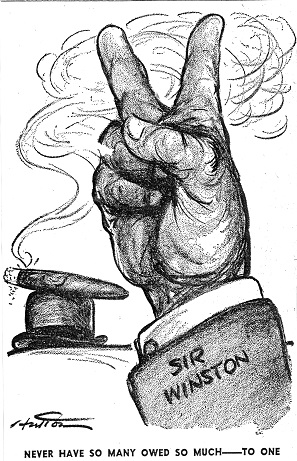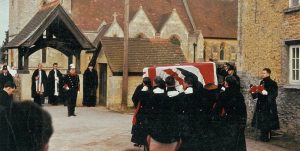Finest Hour 167
Books, Arts & Curiosities – Craning for Attention

August 2, 2015
Finest Hour 167, Special Issue 2015
Page 24
By DAVID FREEMAN
 To mark the fiftieth anniversary of the State Funeral of Sir Winston Churchill, BBC One produced a one-hour documentary presented by Jeremy Paxman. Using archival footage and interviews with survivors who took part in the ceremonies, the results are splendid—but for one not-so-small detail.
To mark the fiftieth anniversary of the State Funeral of Sir Winston Churchill, BBC One produced a one-hour documentary presented by Jeremy Paxman. Using archival footage and interviews with survivors who took part in the ceremonies, the results are splendid—but for one not-so-small detail.
First, though, the good: Paxman speaks with London Mayor Boris Johnson, author of The Churchill Factor (reviewed in FH 166) about the relevancy of Churchill’s legacy. The ever-effusive Johnson will have no part of Paxman’s suggestion that Churchill may not be part of the consciousness of today’s youth.
Churchill’s grandchildren Sir Nicholas Soames and Celia Sandys provide personal memories from the family, while Lady Williams (formerly Jane Portal, personal secretary from 1949-55) illustrates the level of devotion among those who worked for Sir Winston.
Paxman visits the Churchill Archives Centre, where Director Allen Packwood shows him the original draft of Operation Hope Not, the official plans for the funeral. Martin Bell, who reported on events in 1965 for the BBC, recalls that revisionist historians had not yet got at Churchill at that time, and the crowds that turned out showed the genuine affection of those who had lived in Britain during the war.
Especially interesting are the memories of Anthony Mather, who was the Officer-in-Charge of the Bearer Party, and Lincoln Perkins, one of the bearers. They recall the moment when Lord Attlee, an honorary pall bearer though a frail 82, stumbled slightly going up the steps of St. Paul’s, causing the actual bearers behind him to falter— just—before successfully recovering.
Also touching are the interviews with Peter Wilson and Basil King, the trumpeters who played “The Last Post” and “Reveille” respectively from high in the dome of St. Paul’s at the end of funeral.
Where Paxman goes awry, however, is when he reaches the description of the coffin’s journey up the Thames on MV Havengore, a launch belonging to the Port of London. The dipping of the dock cranes along Hay’s Wharf as the boat passed carrying Churchill’s remains has gone down in legend as a “spontaneous” gesture, the moment Sir Nicholas recalls that “undid us all.”
It is more correct, though, to say that the tribute was “unexpected,” since it was not part of the official plans known to the family and released to the media. The idea originated with Sir David Burnett, the managing director of Hay’s Wharf Limited: “We thought we should add our own little tribute to Sir Winston,” he told the Daily Mail on 1 February 1965.
In an article prepared for the Radio Times to promote his documentary, Paxman explains that the crane salute also required a good deal of planning in advance, since extra generators needed to be brought in to operate all thirty-six cranes simultaneously, not a normal occurrence. Additionally, since the funeral took place on a Saturday, dockers would have to come in on a day off to handle the cranes.
Paxman alleges that the dockers were induced to cooperate only when they were promised payment for overtime. But in the Daily Mail story from 1965, Sir David is quoted as saying, “The dock workers concerned immediately agreed to give up their time off….Our men have not asked for any overtime. They will be paid something to cover their expenses.”
More egregious, however, is Paxman’s general assertion that most dockers disliked Churchill, implying that the crane salute only transpired by money changing hands. He interviews a man identified as a docker from 1965 who states, “I think I can speak for most of them,” when he asserts, “they didn’t like Churchill” and would not have operated the cranes during the funeral but for payment.
After the broadcast, The Churchill Centre received a letter from Julie Costin who expressed her anger by writing, “I was so annoyed by the dock worker in that programme saying that all the Dockers hated Sir Winston.” “I come from a long line of Dockers,” Julie continued, “including my two grandfathers, my father, several uncles and cousins….I only remember them speaking very highly of Sir Winston, even though they were lifelong Labour supporters as was most of the old working class.”
 The tone of the documentary recovers, however, when Paxman interviews the fireman from the funeral train that bore the coffin from Waterloo to Hanborough, the station nearest to Bladon. Jim Lester remembers the thousands who lined the route, including the many old soldiers wearing their medals.
The tone of the documentary recovers, however, when Paxman interviews the fireman from the funeral train that bore the coffin from Waterloo to Hanborough, the station nearest to Bladon. Jim Lester remembers the thousands who lined the route, including the many old soldiers wearing their medals.
Finally, Paxman meets with Frank Hall, who was the Verger of the Parish Church of St. Martin’s when Churchill was finally laid to rest. Though the committal was a private ceremony, some villagers in Bladon took photographs of the coffin’s arrival, which Hall is now able to share half a century on.
Do watch this documentary now posted on YouTube, but also bear in mind the words of Sir David Burnett and Julie Costin when you do.
The editor is grateful to Mr. Rodney Croft for assistance in researching this article.
Subscribe
WANT MORE?
Get the Churchill Bulletin delivered to your inbox once a month.





